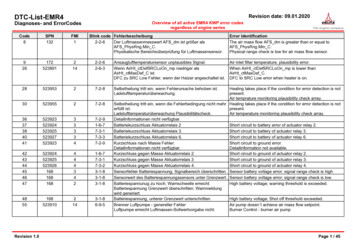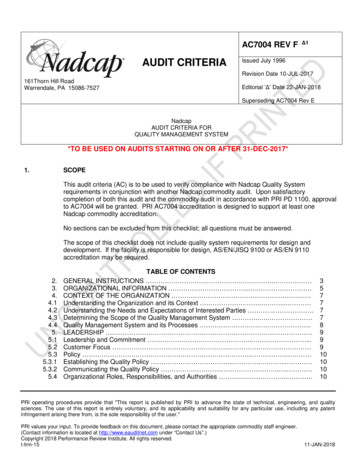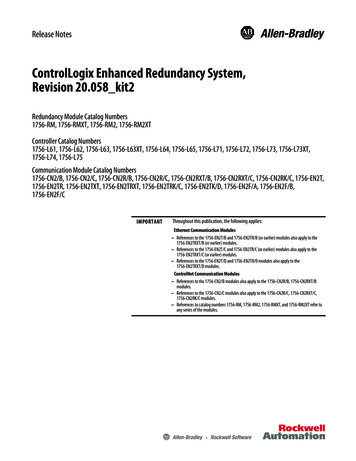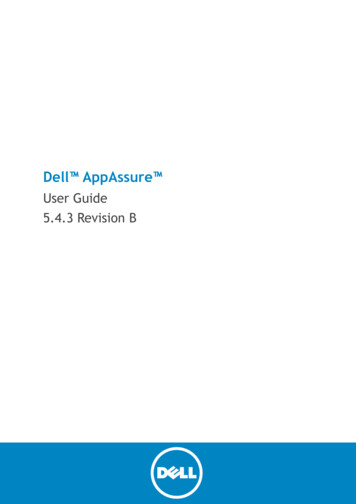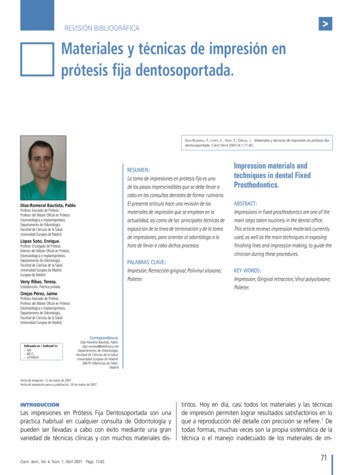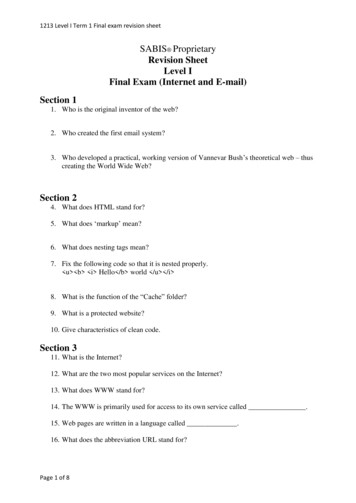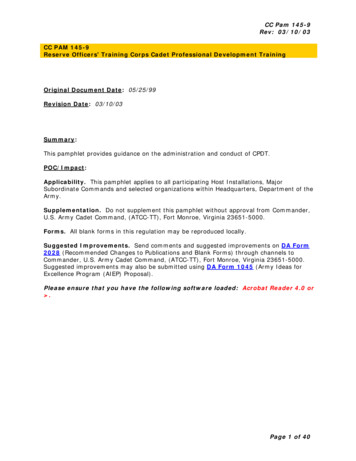
Transcription
CC Pam 145-9Rev: 03/10/03CC PAM 145-9Reserve Officers' Training Corps Cadet Professional Development TrainingOriginal Document Date: 05/25/99Revision Date: 03/10/03Summary:This pamphlet provides guidance on the administration and conduct of CPDT.POC/Impact:Applicability. This pamphlet applies to all participating Host Installations, MajorSubordinate Commands and selected organizations within Headquarters, Department of theArmy.Supplementation. Do not supplement this pamphlet without approval from Commander,U.S. Army Cadet Command, (ATCC-TT), Fort Monroe, Virginia 23651-5000.Forms. All blank forms in this regulation may be reproduced locally.Suggested Improvements. Send comments and suggested improvements on DA Form2028 (Recommended Changes to Publications and Blank Forms) through channels toCommander, U.S. Army Cadet Command, (ATCC-TT), Fort Monroe, Virginia 23651-5000.Suggested improvements may also be submitted using DA Form 1045 (Army Ideas forExcellence Program (AIEP) Proposal).Please ensure that you have the following software loaded: Acrobat Reader 4.0 or .Page 1 of 40
CC Pam 145-9Rev: 03/10/03Table Of ContentsChapter 1, Introduction1-1Purpose1-2References1-3Explanation of Abbreviations and Terms1-4Program Objectives1-5GeneralChapter 2, Cadet Professional Development Training CPDT) Program2-1GeneralSection I, Cadet Troop Leadership Training (CTLT) Program2-2CTLT Program2-3CTLT Program Prerequisites2-4CTLT Program ResponsibilitiesSection II, Cadet Practical Field Training (CPFT) Program2-5CPFT Program2-6CPFT Program Prerequisites2-7CPFT Program ResponsibilitiesChapter 3, ROTC CPDT Spaces and Assignments3-1General3-2CTLT Assignments3-3CTLT Internship Program3-4CPFT Assignments3-5Spaces3-6Training DatesChapter 4, Service with UnitsSection I, Cadets Limitations, Duties, and Military Courtesy4-1Limitations4-2Duties4-3Military Courtesy4-4AuthorizationPage 2 of 40
CC Pam 145-9Rev: 03/10/03Section II, Permissive Parachute Jumping4-5Participation4-6ResponsibilitiesSection III, Security Clearance4-7ParticipationSection IV, Uniform and Insignia4-8On-Duty and Off-Duty UniformSection V, CPDT Counseling and Evaluations4-9Performance4-10ProceduresSection VI, Operation of Motor Vehicles/GSA4-11Operation of Military/GSA Vehicles4-12Privately Owned Vehicles (PVA)Section VII, Program Evaluation4-13Evaluation of ROTC CTLT ProgramChapter 5, Administrative Details5-1CTLT/CPFT Orders5-2Reporting Procedures5-3Departing Procedures5-4Morning Report5-5Cadet Identification Card5-6ROTC Liaison Visits5-7Hospitalization & Cadet Health gency Leave5-12Clothing and Equipment5-13AwardsPage 3 of 40
CC Pam 145-9Rev: 03/10/03Chapter 5, Administrative Details (continued)5-14Information Activities5-15Pay and s and Responsibilities of Cadet SupervisorsCCTLT Counseling and EvaluationsDQualification Criteria for the Combat Divers Qualification Course (CDQC)Page 4 of 40
CC Pam 145-9Rev: 03/10/03Chaper 1, Introduction1-1. PurposeTo provide guidance for the conduct of the ROTC Cadet Professional Development Training(CPDT) Program.1-2. ReferencesReferences listed in Appendix A.1-3. Explanation of Abbreviations and TermsAbbreviations also referenced in the Right Site Glossary.1-4. Program Objectivesa. Increase each cadet's leadership development by assigning them to a platoon leader orlike position with specific responsibilities and opportunities to lead soldiers.b. Familiarize Cadets with the command, training, administration, and logistical functionsof assigned units.c. Expose Cadets to the on-duty and off-duty environment of the junior officer.d. Familiarize Cadets with the Junior Officer Development System and Officer ProfessionalManagement System (OPMS).e. Provide Cadets an opportunity to attend active duty skill enhancement schools withactive Army personnel.1-5. Generala. All ROTC Cadets participating in the CPDT program are volunteers. The program ishighly competitive and Cadets are selected to participate by their Professor of MilitaryScience (PMS).b. Cadets volunteering for CPDT Cadet Troop Leadership Training/Cadet Practical FieldTraining (CTLT/CPFT) allocation must fulfill their training commitment. Prior to reportingto National Advanced Leadership Camp (NALC), if a cadet requests release or earlydeparture, only documented extenuating or emergency situations will be considered forapproval. Submit withdrawal request through the cadet's chain of command to theirrespective Brigade Commander. Cadets may request and receive an extension of theassignment if the unit’s commander and the cadet's PMS support the request.Chapter 2, Cadet Professional Development Training ProgramCPDT consists of two sub-programs: Cadet Troop Leadership2-1. General.Training and the Cadet Practical Field Training Programs.Page 5 of 40
CC Pam 145-9Rev: 03/10/03Section ICadet Troop Leadership Training Program2-2. CTLT Programa. CTLT is a two-track program consisting of a platoon leader track and an internshiptrack. Successful completion of NALC is a non-waiverable prerequisite. In this program,the cadet's future military goals (branching) or desired unit (location) are considered infinalizing the cadet’s CTLT assignment. The typical CTLT program period is 18 – 21 daysin the Continental United States (CONUS) and 27 – 30 days Outside Continental UnitedStates (OCONUS).b. The platoon leader track consists of platoon leader positions identified by active Armyline units. Cadets are assigned to these positions following attendance and successfulcompletion of NALC. Cadets receive an Officer Evaluation Report (OER) upon completion ofthe platoon leader assignment.c. The internship track consists of 13 internship programs. The assignment period is thesame as the platoon leader track with the exception of selected internship programs inwhich Cadets are assigned for a four-week period. Cadets receive an OER upon completingthe internship assignment. The internship positions are as follows:(1) Army Medical Department Internship Program (AMEDDIP).(2) Army Science Board Internship Program (ASBIP).(3) Central Identification Laboratory Intern-ship Program (CILIP).(4) Cadet Installation and Environment Internship Program (CIEIP).(5) Cadet Internship Program (CIP).(6) Defense Information Systems Agency Internship Program (DISAIP).(7) Engineering Internship Program (EIP).(8) Health Facilities Planning Agency Intern-ship Program (HFPAIP).(9) John F. Kennedy Special Warfare Intern-ship Program (JFKSWIP).(10) Lawrence Livermore Laboratory Intern-ship Program (LLLIP).(11) National Ground Intelligence Center Internship Program (NGICIP).(12) Nurse Summer Training Program (NSTP).(13) Olmsted Foundation Cadet Overseas Travel and Cultural Immersion Program(OFCOT).2-3. CTLT Program Prerequisitesa. The priority of fill for participation in CTLT training opportunities is Military Science (MS)III Cadets. MS IV Cadets who did not attend or failed to successfully complete NALC theprevious year are eligible to participate after successful completion of NALC if graduationwill occur in December or later.b. MS V and VI Cadets may participate in CTLT but only after all MS IIIs have beenconsidered.Page 6 of 40
CC Pam 145-9Rev: 03/10/032-4. CTLT Program Responsibilitiesa. United States Army Cadet Command (USACC) Director of Leader Development (DOLD)will designate a CPDT Program Manager to execute and oversee the CTLT and CPFTprograms from within the DOLD staff. Subordinate program managers for CTLT and CPFTwill report to the CPDT Program Manager.b. CTLT Program Manager will:(1) Provide guidance, assistance, and coordination to regions and CTLT hosting elements.(2) Conduct initial staff coordination and planning from August through June each yearand manage the program for the remainder of the year.(3) Conduct direct coordination with USACC Resource Management, Chief Nurse,Information Management Office, and elements hosting the CTLT program within DOD, DA,8th Army, 7th Army, TRADOC, and FORSCOM.(4) Request CTLT slots from hosting CTLT elements via a memorandum NLT the secondweek of August. The memorandum will announce CTLT time frames based on USACC’sTraining Guidance for NALC graduation dates.(5) Instruct CTLT hosting elements to identify CTLT positions within sub-elements andsubmit position information to USACC, (ATCC-TT) (CTLT Program Manager) NLT 30November.(6) Prepare a separate memorandum for CTLT positions within DA staff agenciesaddressed to the Director of the Army Staff. Route the memorandum through CG, USAACto the Director of the Army Staff.(7) Upon receipt of all CTLT positions, compile positions into allocations by branch, genderand location. Compilation of allocations is based on the total percentage of contracted MSIII Cadets coded E, G, J, and L, and non-contracted Cadets coded B, H, I, R, S, U, and Vwithin each region. Non-contracted Cadets must be contracted before arriving at NALC.(8) Provide each region with an Excel spread-sheet consisting of each regiments' CTLTallocations, by assigned region NLT 28 February. For an example of a CTLT allocationExcel spreadsheet, refer to the Cadet Command web site at:http://www.rotc.monroe.army.mil/(9) Import CTLT positions to Cadet Command Information Management System (CCIMS)and allocate to regions NLT 3 March.(10) Perform deletions, edits, and additions in CCIMS on CTLT allocations as required.(11) Provide an updated listing of Hosting Element/Installation Project Officers NLT 30May.(12) Compile a weekly CTLT Fill Report by region during the months of April throughJune.Page 7 of 40
CC Pam 145-9Rev: 03/10/03(13) Provide hosting elements’ CTLT Project Officer (CTLT PO) a Cadet Assignment List,which reflects location of assignment, cadet names, university or college, region, branchassignment, CTLT report/depart dates, and e-mail addresses NLT 30 May.(14) Obtain memorandum on Dining Facility Support from USACC Resource Managementand provide to Army installations hosting CTLT training NLT 15 May.(15) Provide assistance to Regions as required, and brigades and battalions when referredby regions.(16) Prepare a consolidated CTLT After Action Report (AAR) NLT 30 October.(17) Plan and coordinate annual CPDT Conference.c. Region Commanders. Designate a region-level CTLT Project Officer (CTLTPO) tocoordinate all actions pertaining to the CTLT with the Cadet Command CTLT ProgramManager.d. Region CTLTPO.(1) Designate the Battalion(s) to provide CTLT Liaison Officers for OCONUS (Germany andKorea), JFKSWG (FT Bragg, NC) and CIP (Washington, DC).(2) Compare allocations listed on the Excel spreadsheet to CTLT allocations reflected inCCIMS. Forward an itemized discrepancy list via e-mail to USACC, DOLD (CTLT ProgramManager) within 48 hours of receiving the CTLT Excel spreadsheet.(3) Allocate CTLT positions to brigades within five working days of CCIMS opening toregion. Base allocations on the total number of contracted MS III Cadets coded E, G, J, orL, and non-contracted Cadets coded B, H, I, R, S, U, or V within each brigade. Noncontracted Cadets assigned in CCIMS for a CTLT allocation must be contracted beforearriving at NALC.(4) Use CCIMS to monitor brigades’ and battalions' fill activities. Ensure battalions assignCadets equally among the available regiments. CTLT allocations returned by brigades maybe redistributed within the region or returned to DOLD.(5) Ensure brigades and battalions adhere to USACC policy of CTLT having priority overCPFT for MS III Cadets.(6) Provide CCIMS assistance to brigades and battalions.(7) Coordinate lodging contracts and IMPAC credit card payments for lodging NLT 45-60days prior to Cadets’ arrival.e. Brigade Commanders. Designate a brigade-level CTLTPO to coordinate all actionspertaining to CTLT with the Region CTLTPO.f. Brigade CTLTPO.Page 8 of 40
CC Pam 145-9Rev: 03/10/03(1) Allocate CTLT positions to battalions within five working days of receiving allocationsfrom the Region. Allocations will be based on the total number of contracted MS III Cadetscoded E, G, J or L, and non-contracted Cadets coded B, H, I, R, S, U, or V within eachbattalion. Non-contracted Cadets assigned in CCIMS for a CTLT allocation must becontracted before arriving at NALC.(2) Use CCIMS to monitor battalions’ fills activities. Battalions will assign Cadets equallyamong available regiments for NALC. For example, battalions sending up to 14 Cadets willassign no more than one cadet per regiment. Battalions sending 14-28 Cadets will assigntwo Cadets per regiment, etc. This distribution does not pertain to Cadets with CTLTfollow-on training. Once a regiment reaches its maximum size, the CCIMS Training Modulewill not allow any more Cadets into that regiment.(3) Monitor CCIMS to ensure battalions do not perform cadet reservations prior to the dateestablished by USACC DOLD. CTLT allocations returned by battalions may be redistributedwithin the brigade or returned to the region for redistribution.(4) Provide CCIMS assistance to battalions.(5) Contact Region CCIMS POC for assistance or obtain authorization via e-mail to contactUSACC's CTLT Program Manager for assistance.g. Battalion Commanders.(1) Ensure each cadet scheduled to attend NALC reviews the Cadet Command branchingweb site and makes four branch selections of interest. The cadet's branch selections ofinterest must be entered into CCIMS at the time of the NALC or CTLT assignment.(2) Recruit Cadets for all cadet internship programs and submit application packets onqualified Cadets IAW guidance listed on the Cadet Command web site NLT 30 January.(3) Assign Cadets’ training allocation NLT five days after receiving CTLT (platoon leader)positions in CCIMS.(4) Ensure only airborne (ABN) qualified Cadets are assigned to CTLT positions designatedas an ABN CTLT position. Ensure copies of ABN qualified Cadets’ orders awarding theParachutist Badge are faxed to the HQ USACC CTLT Program Manager (757) 788-5454/DSN680 NLT 15 March.(5) Allocations for approved internships will be imported to CCIMS. Internship approvalwill be provided via e-mail. Copies of orders approved by USACC RM must be faxed to theUSACC CTLT Program Manager for inclusion in the request packet for advance per diem.(6) Educate Cadets on the CTLT program and realistic expectations about the program.Inform Cadets that failure to attend or complete NALC will result in the cancellation of theCTLT assignment.(7) Educate Cadets that duration of CTLT is 21 days CONUS and 30 days OCONUS andthat early release approval is on a case-by-case basis for extenuating or emergencyreasons only.Page 9 of 40
CC Pam 145-9Rev: 03/10/03(8) In cases of extenuating circumstances when early release and/or extension is beingsubmitted, contact the hosting element's CTLT Project Officer and USACC CTLT ProgramManager.(9) Assign Cadets to CTLT positions within five working days after receiving allocationsfrom the Brigade. Only assign MS III Cadets coded E, G, J, or L, or non-contracted Cadetscoded B, H, I, R, S, U, or V. CTLT slots not filled at the distributed battalion will bereturned to brigade for redistribution and fill NLT the end of March.(10) Assign Cadets equally among available regiments for NALC. For example, battalionssending 1 to 14 Cadets will assign no more than 1 cadet per regiment. Battalions sending14-28 Cadets will assign 2 Cadets per regiment, etc. This distribution does not pertain toCadets with CTLT follow-on training. Once a regiment reaches its maximum size, theCCIMS Training Module will not allow any more Cadets into that regiment.(11) Do not schedule/perform cadet reservations in CCIMS prior to the date established byUSACC DOLD.h. Hosting Element/Installation CTLTPO(1) Upon receipt of USACC's memorandum requesting CTLT positions, survey all eligibleunits to obtain platoon leader or internship positions and provide the position information toUSACC CTLT Program Manager (ATCC-T) NLT 30 November.(2) Provide cadet position information in an Excel spreadsheet format including thefollowing data: branch category of CTLT position, battalion and company name, unitlocation, reporting and departing dates IAW NALC graduation dates, gender, physicalrequired, jump qualified cadet requirement, National Agency Check (NAC) requirement forthe position and CTLTPO's e-mail address and telephone number. For format and formatkey, please refer to: http://www.rotc.monroe.army.mil/.(3) Identify available Dining Facility (DFAC) for Cadets, ensuring availability to the CTLTunit of assignment, and ensure the commander of the CTLT unit issues a meal card to eachassigned cadet. Cadets participating in the CTLT program do not receive subsistenceallowance and are not reimbursed for funds spent on meals. Cadets require reasonableaccess to a DFAC. If not within reasonable distance, the CTLTPO must ensure that theassigned unit provides roundtrip transportation to the DFAC.(4) Obtain copy of USACC's Resource Management (RM) current year memorandum fordining support from USACC's CTLT Program Manger NLT 30 days prior to Cadets' arrivaland distribute to DFACs supporting CTLT units.(5) Ensure that hosting unit commanders are knowledgeable of CTLT programrequirements. Provide a copy of this pamphlet to all commanders providing CTLT positionsto USACC. Ensure units provide Welcome Packets to Cadets prior to arrival. Collect andship all welcome packets together NLT 1 May. Write on the shipping container: "CadetWelcome Packets" Fort . Ship container to: Commander, NALC, U.S. Army ROTC 4thRegion, (ATOD-T), Box 339500 MS83, Fort Lewis, WA 98433-9500.(6) When requested by USACC CTLT Program Manager, the Installation CTLTPO willprovide an updated Location Information Sheet. See sample at:http://www.rotc.monroe.army.mil/.Page 10 of 40
CC Pam 145-9Rev: 03/10/03(7) Coordinate transportation for Cadets to and from airport. Upon arrival, collect ordersand coordinate return flights through Carlson Wagonlit Travel/Almeda Travel. Cadets areonly authorized return travel to Home of Record (HOR) or School of Record (SOR). Cadetsdesiring a different return location must pay the difference in cost.(8) Coordinate requests for extension or early release from CTLT assignments with theCTLT Program Manager only. Coordination must be via e-mail and/or telephone. USACCDOLD is the approval authority for request for extensions or early CTLT release.(9) Collect all CTLT AARs and compile a consolidated hosting element/ installation AAR andprovide to USACC DOLD NLT 23 September. See:http://www.rotc.monroe.army.mil/for format.i. Commanders, Hosting CTLT.(1) Designate a unit CTLT Liaison Officer (CTLT LNO). The Unit LNO will be responsible tocoordinate CTLT issues or cadet issues with the Host Element/Installation CTLTPO.(2) Ensure unit CTLT LNOs coordinate with the Host Element/Installation CTLTPO prior toCadets arrival to update program or assignment changes.(3) Assign a sponsor (normally a 2LT) for each position identified for fill by a cadet.Provide sponsor’s name, e-mail, address and telephone number(s) to the hostingelement/installation CTLTPO.(4) Identify platoon leader positions for participation in the CTLT program and provide theinformation to the Host Element/Installation CTLTPO. Position information includes thefollowing data: branch category of CTLT position (i.e. CS/IN), battalion and company nameand location, reporting and departing dates provided by PO, gender, physical required,airborne requirement, and National Agency Check (NAC) requirement for the position.(5) Brief all unit personnel on the status and position of Cadets.(6) Assimilate the cadet into the unit quickly and provide the best possible trainingexperience. Assign Cadets to positions of responsibility and interaction with junior soldiersand senior noncommissioned officers. Do not assign Cadets to positions that include officeor purely administrative functions. Positions such as assistant operations, training, orsupply,
Oct 03, 2003 · Management System (OPMS). e. Provide Cadets an opportunity to attend active duty skill enhancement schools with active Army personnel. 1-5. General . a. All ROTC Cadets participating in the CPDT program are volunteers. The program is highly competitive and Cadets are selected to participate by their Professor of Military Science (PMS). b.File Size: 638KB
